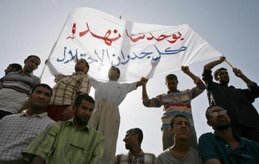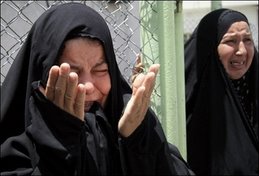Hospital Struck As US Military Tightens Siege Of Baghdad's Sadr City
05 May, 2008WSWS.org
US missile strikes on a small building adjacent to a major hospital in Baghdad’s Sadr City on Saturday left more than 20 people injured, destroyed ambulances and shook the entire neighbourhood. The incident provides a glimpse of the hellish conditions created for residents of the huge working class slum through the month-long siege by American and Iraqi government forces.
A US military statement claimed that “intelligence reports” had identified the targetted building as “a command and control centre used by criminal elements”. Military spokeswoman Megan Burmeister blamed “criminal groups operating directly out of civilian neighbourhoods”. Colonel Gerald O’Hara insisted that “great care [was taken] to prevent any collateral damage”. The missiles were “precision guided”.
These comments stand reality on its head. The US-led drive into Sadr City is aimed at destroying the Mahdi Army militia of Shiite cleric Moqtada al-Sadr and suppressing all resistance in the area, which has been a hotbed of opposition to the American occupation. “Criminal elements” and “criminal groups” are the latest buzzwords employed by the US military and the puppet government of Prime Minister Nouri al-Maliki to justify transforming the densely-populated suburb into a battle zone.
There is no way of knowing who was in the building flattened by US missiles. Locals told the media that it was a small centre used by pilgrims. A sign on the gate outside read “Imam Hussein’s Resthouse”, according to the New York Times. Of course, none of the “intelligence reports” were released. In any case, the real criminals are not the Mahdi Army militia, which has widespread support among the local population, but the US military which is seeking to consolidate its colonial-style occupation of Iraq.
Claims that it was a “precision” attack are absurd. “The first missile hit the building next door. The second struck an area used as a parking lot for the hospital’s ambulances, damaging a water line and creating a small pond, as well as destroying three ambulances and shattering windows in others. A third missile hit a generator nearby that supplied the neighbourhood; the hospital’s generator was not damaged,” the New York Times stated.
Agence France Presse (AFP) reported from the scene that the “hospital was badly damaged and a fleet of ambulances was destroyed. Just outside the hospital, a shack which appeared to have been the target was reduced to a pile of rubble... The hospital corridors were littered with glass shards, twisted metal and hanging electrical wiring. Partitions in the wards had collapsed. Huge concrete blocks placed to form a blast wall against explosions had toppled onto parked vehicles.”
Hospital staff said the number of injured was at least 28. Head of the Baghdad health department, Dr Ali Bistan, angrily told AFP: “They [the Americans] will say it was a weapons cache. But in fact they want to destroy the infrastructure of the country.”
Sadrist parliamentarian Nassar al-Rubaie told the media: “We blame the government as it stands watching quietly and does not lift a hand. The air strikes are targetting civilians... Today was a serious case because it included the hospitals and the ambulances. This is aggression in the full sense of the word.”
The US-led drive into Sadr City was launched in March as the Maliki government initiated an offensive in the southern port city of Basra against Mahdi Army strongholds. The militia was compelled to adopt a largely defensive posture after Sadr, as part of his political manoeuvring, ordered his fighters off the street and maintained a unilateral ceasefire announced last August.
Far from halting operations in response to the ceasefire, US and Iraqi forces have stepped up their attacks on the pretext of destroying “criminal elements”, rather than Mahdi Army fighters. Prime Minister Maliki issued a blunt ultimatum last week demanding the disarming of the Mahdi Army and the handover of “all wanted fugitives”. To refuse these conditions, he declared, “means the continuation of the government’s efforts to disarm them by force”. Most of Basra is now under the control of government forces, but Sadr City and other major Shiite strongholds in Baghdad have been under siege for more than a month. Millions of people are struggling to survive day by day.
The Iraqi Red Crescent Organisation told Time magazine last Wednesday that hundreds had fled the fighting and the oppressive curfews, which have cut access to food, water and electricity. Many more have moved to the northern areas, away from clashes in the southern sectors of the suburb, Mohammed Kamel Hassan, a volunteer organiser for the aid group explained. He said that up to one million Sadr City residents needed emergency aid, while his organisation had only 575 volunteers to deliver basic food stuffs.
“Sadr City right now is like a city of ghosts,” Abu Haider al-Bahadili, a Mahdi Army leader told the Washington Post by phone. “It has turned from a city into a field of battle.” The US military claimed to have killed 14 militants in fighting on Saturday and another nine in helicopter strikes on Sunday. However, the dead could well have been civilians rather than fighters. Tehseen Sheikhly, a spokesman for the government’s Baghdad security plan, announced last week that 925 people had died in Sadr City since late March and another 2,605 were injured. Most of the casualties were civilians.
Threats against Iran
As the offensives against Shiite militias in Basra and Baghdad have continued, the Bush administration and the Pentagon have maintained a steady stream of accusations that Iran has been arming, training and directing anti-occupation militia. Following his congressional testimony last month, the top American commander in Iraq, General David Petraeus, ordered that a dossier be drawn up to demonstrate Iranian interference.
The release of the dossier has been put on hold, however, reportedly after the Maliki government suggested sending a delegation to Tehran to confront the regime with the purported evidence. “It’s in Prime Minister Maliki’s hands right now, the evidence as to whether or not he has been lied to, bald-faced lied to, by the Iranian government,” the Pentagon’s director of planning, Lieutenant General John Saddler told the media.
The Maliki government rests on two Shiite parties—Da’wa and the Islamic Supreme Council of Iraq (ISCI)—which have longstanding links to the Iranian regime. As a result, Baghdad is desperate to avoid any US military clash with Iran. Maliki adviser Sadiq Rikabi told the Los Angeles Times: “We are worried about any escalation between the United States and Iran for a simple reason: We are the weakest party in this game.”
Iraqi officials declared that the delegation, which included senior Da’wa and ISCI officials, would confront Tehran with details of Iranian association with militias—including names, weapons and training camps. Over the past year, the only evidence made public by the American military have been displays of Iranian weapons, but no conclusive proof that the Iranian regime has supported sections of the Mahdi Army.
During discussions with the delegation, Iran once again denied the allegations. The Wall Street Journal reported last week that Tehran had sent a series of messages to Washington via diplomatic back channels, denying any support for the militias fighting in Basra and expressing concern about escalating unrest. “The general theme was that they were afraid the violence would get out of hand,” one military official told the newspaper. The delegation returned on the weekend with an agreement from Iran to help “stabilise security” in Iraq.
The deal will undoubtedly be ignored by the Bush administration which has been steadily increasing the drum beat against Iran, not only over its “meddling” in Iraq, but also its alleged nuclear weapons programs. General Petraeus was in London last Thursday for discussions over strategy with British military officials and political leaders. He again highlighted the large quantities of Iranian weapons found in Basra and Baghdad, declaring it to be “very, very significant”.
US Joint Chiefs of Staff chairman, Admiral Michael Mullen, added a new element to the threats against Iran, arguing last Wednesday that the US presidential election was a “time of vulnerability” for the US. He said the political transition was “extraordinarily challenging” given US military involvement in Iraq and Afghanistan. “Iran is not going away,” he told the Washington Post. “We need to be strong and really in the deterrent mode, to not be very predictable.”
Just how far the Bush administration is prepared to go in proving its unpredictability remains to be seen. However, there have already been a number of media leaks indicating that the Pentagon is drawing up plans for a military strike on Iran. In the same press conference that he accused Iran of “bald-faced lies”, Lieutenant General Saddler denied a CBS television report of preparations for a strike on Iranian Revolutionary Guards Corp (IRGC) bases purportedly training Iraqi militiamen.
The leaks continue, however. The London-based Sunday Times yesterday reported that US plans for an attack on IRGC were being made. “If the situation in Basra goes back to what it was like before, America is likely to blame Iran and carry out a surgical strike on a militant training camp in [the neighbouring Iranian province of] Khuzestan,” a source told the newspaper. Such aggression on the part of the US would dramatically raise tensions with Iran and the likelihood of war.
وأصدرت منظمة الأمم المتحدة للأمومة والطفولة "اليونسيف" بياناً الاثنين، تضمن هذه التقديرات، نقلت فيه عن الحكومة العراقية أن مواجهات الأسبوع الماضي بحي الصدر أسفرت عن سقوط حوالي 925 قتيلاً، وأكثر من 2600 جريحاً.
وقالت اليونسيف في بيانها: "أبلغت منظمات غير حكومية بأن 60 في المائة من هؤلاء، هم من الأطفال والنساء، الذين لا يشاركون بتلك العمليات القتالية."
واندلعت الاشتباكات في حي الصدر بين القوات الأميركية والقوات العراقية من جهة، وعناصر "جيش الهدي" الموالية للزعيم الشيعي مقتدى الصدر، من جهة أخرى، في أعقاب هجوم قادته القوات العراقية على المسلحين في مدينة البصرة جنوبي البلاد الشهر الماضي.
وأدى الهجوم، الذي استهدف عناصر وصفتها الحكومة العراقية بأنها "خارجة عن القانون"، إلى اندلاع معارك في قلب المناطق الشيعية بالجنوب، وامتدت لتشمل مناطق أخرى للشيعة في بغداد.
وكانت ثلاثة أطفال قد قُتلوا في وقت سابق هذا الأسبوع، وأصيب رابع، نتيجة غارة جوية أمريكية شرقي بغداد، حيث تخوض قوات التحالف مواجهات عنيفة مع عناصر جيش المهدي.
ودفع مقتل هؤلاء الأطفال الجيش الأميركي إلى إلقاء منشورات دعا فيها سكان حي الصدر، إلى التعاون بالحملة ضد "العناصر الإجرامية"..
وكانت مسؤولة دولية رفيعة المستوى، أطلقت مؤخراً "صيحة فزع" جديدة إزاء الوضع الذي آل إليه أطفال العراق، الذين يتقاذفهم المرض والشوارع ومليشيات العنف.
وقالت الممثلة الخاصة للأمين العام لشؤون الأطفال والنزاعات المسلحة، راديكا كوماراسوامي، لدى اختتام زيارتها للعراق مؤخّراً، إنّ أطفال العراق هم "الضحايا الصامتون" للعنف الدائر.
وعلى صعيد التطورات الميدانية، فقد خلفت موجة جديدة من العمليات القتالية بالعاصمة العراقية نحو عشرة قتلى من العناصر المسلحة، حسبما أكد الجيش الأميركي.
إلا أن مصادر بوزارة الداخلية العراقية قالت إن المواجهات، التي بدأت مساء الأحد واستمرت حتى صباح الاثنين، بعدد من الأحياء الشيعية في بغداد، أسفرت عن سقوط 13 قتيلاً، بينهم عدد من المدنيين.











